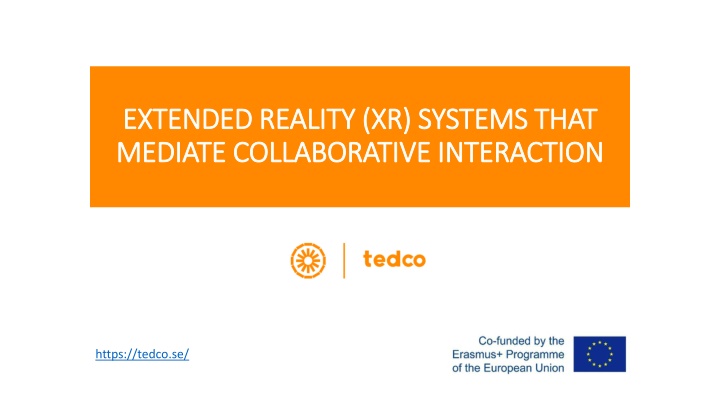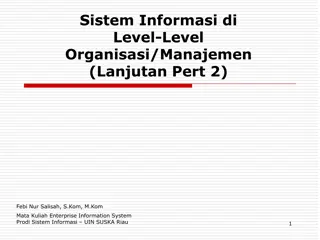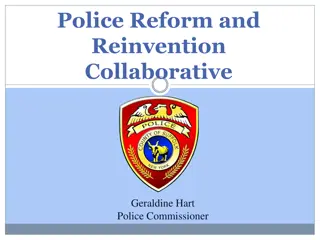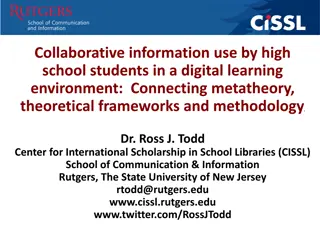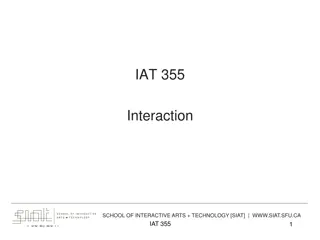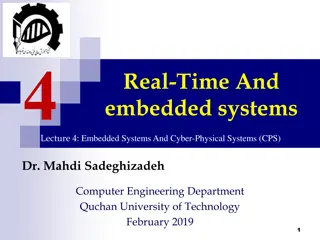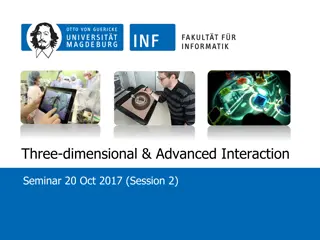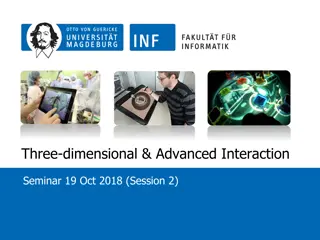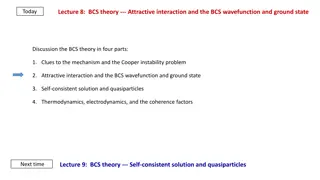XR Systems for Collaborative Interaction
Delve into the realm of Extended Reality (XR) systems enabling collaborative interaction, encompassing design components, mediating features, and challenges. Encounter a taxonomy for synchronous collaborative interaction in XR environments, along with the evolution of virtual collaboration technologies.
Download Presentation

Please find below an Image/Link to download the presentation.
The content on the website is provided AS IS for your information and personal use only. It may not be sold, licensed, or shared on other websites without obtaining consent from the author.If you encounter any issues during the download, it is possible that the publisher has removed the file from their server.
You are allowed to download the files provided on this website for personal or commercial use, subject to the condition that they are used lawfully. All files are the property of their respective owners.
The content on the website is provided AS IS for your information and personal use only. It may not be sold, licensed, or shared on other websites without obtaining consent from the author.
E N D
Presentation Transcript
EXTENDED REALITY (XR) SYSTEMS THAT EXTENDED REALITY (XR) SYSTEMS THAT MEDIATE MEDIATE COLLABORATIVE INTERACTION COLLABORATIVE INTERACTION https://tedco.se/
Summary & Learning Goal Summary & Learning Goal Students will be able to; identify different components of designing XR systems that mediate collaboration. describe relevant mediating features for designing and evaluating XR systems for collaboration critically reflect on the opportunities and challenges of the XR systems that mediate collaboration. The students are introduced to the taxonomy for synchronous collaborative interaction in social extended reality (XR) environments. This includes understanding the main components for designing XR platforms that mediate collaboration. Opportunities and challenges of current virtual systems in mediating collaborative interaction are presented for future design considerations.
Content Content / / Outline Outline Introduction to a brief history of XR and XR taxonomy Main challenges and opportunities offered by XR systems in mediating collaborative interaction Main components of XR system design: Environments, Avatars, Interaction Future Directions
Recommended Recommended readings readings Sch fer, A., Reis, G., & Stricker, D. (2022). A Survey on Synchronous Augmented, Virtual, and Mixed Reality Remote Collaboration Systems. ACM Computing Surveys, 55(6), 1- 27. https://doi.org/10.1145/3533376 Barrett Ens, Joel Lanir, Anthony Tang, Scott Bateman, Gun Lee, Thammathip Piumsomboon, and Mark Billinghurst. 2019. Revisiting collaboration through mixed reality: The evolution of groupware. International Journal of Human-Computer Studies 131 (2019), 81- 98. https://doi.org/10.1016/j.ijhcs.2019.05.011
BRIEF HISTORY OF EXTENDED REALITY (XR) BRIEF HISTORY OF EXTENDED REALITY (XR) MEDIATED COLLABORATIVE WORK MEDIATED COLLABORATIVE WORK BRIEF HISTORY OF VIRTUAL SYSTEMS THAT MEDIATE COLLABORATION Computer-Supported Cooperative Work (CSCW) has long been concerned with understanding and designing technologies to support collaboration. From this field, rich theories and practices about how people work together have influenced the design of collaboration technologies.
BRIEF HISTORY OF EXTENDED REALITY (XR) BRIEF HISTORY OF EXTENDED REALITY (XR) MEDIATED COLLABORATIVE WORK MEDIATED COLLABORATIVE WORK BRIEF HISTORY OF VIRTUAL SYSTEMS THAT MEDIATE COLLABORATION Some of the earliest examples of collaboration technology in virtual environments: - Ultimate Display by Ivan Sutherland (1965) - the real and digital spaces were seamlessly combined, - oN-Line System (1968) or The Mother of All Demos (1969) by Engelbart and English - first illustrated video conferencing and screen sharing in a real-time collaborative text editor, - a head mounted display (HMD) by Sutherland (1968) - combined two small cathode ray tubes with transparent optical elements to overlay virtual images on the real world which was known as the first fully working AR system, - Video Draw (1990) and Video Whiteboard (1991) by Tang and Minneman, and Clear Board (1993) by Ishii et al. - using cameras and half-silvered mirrors to provide a more realistic rendition of a virtual collaborator s eye gaze, - teleconference applications where people used tracked AR displays to view live virtual video of remote collaborators superimposed over the real world (e.g., Billinghurst and Kato, 2002). Sch fer, A., Reis, G., & Stricker, D. (2022). A Survey on Synchronous Augmented, Virtual, and Mixed Reality Remote Collaboration Systems.ACM Computing Surveys,55(6), 1- 27. https://doi.org/10.1145/3533376
INTRODUCTION: EXTENDED REALITY (XR) INTRODUCTION: EXTENDED REALITY (XR) What is Extended Reality according to you? How does collaborative interaction differ in different realities (e.g. virtual, augmented, mixed)?
INTRODUCTION: EXTENDED REALITY (XR) INTRODUCTION: EXTENDED REALITY (XR) WHAT IS EXTENDED REALITY (XR)? Extended Reality is an umbrella term for technologies that merge immersive digital environments with the physical world. The term broadly involves different yet interlocking technologies: virtual reality (VR), augmented reality (AR) and mixed reality (MR). Mixed Reality (MR) Real Augmented Reality (AR) Augmented Virtuality Virtual Reality (VR) Environment Adapted from: Milgram, P., & Kishino, F. (1994). A taxonomy of mixed reality visual displays. IEICE TRANSACTIONS on Information and Systems, 77(12), 1321-1329. http://citeseerx.ist.psu.edu/viewdoc/summary?doi=10.1.1.102.4646
OPPORTUNITIES OF XR FOR COLLABORATIVE OPPORTUNITIES OF XR FOR COLLABORATIVE INTERACTION INTERACTION Augmented Reality (AR), Mixed Reality (MR) and Virtual Reality (VR) technologies are developing slowly but steadily. They are becoming more mature and open new ways for remote collaboration. Instance: Companies Explore Virtual Worlds As Collaboration Tools https://www.cio.com/article/274106/collaboration-companies-explore-virtual-worlds-as-collaboration-tools.html
XR IN MEDIATING COLLABORATIVE XR IN MEDIATING COLLABORATIVE INTERACTION INTERACTION POSSIBILITIES OF THE VIRTUAL CONTINUUM FOR COLLABORATIVE INTERACTION Augmented Reality (AR) - support collaborative interaction by aligning digital content with the physical world around the collaborators, drawing attention to the material, and stimulating collaboration among people both in the real and the virtual spaces Virtual Reality (VR) - mimic the feeling of real social interaction, and further create its own realm of communication through transformed social interactions (i.e., it can present a different reality for different users depending on their individual needs.) Mixed Reality (MR) a combination of both AR and VR hardware and thus the possibilities for collaborative interaction Image created by Dall-E with the description "multiple people interact collaboratively in extended reality". Retrieved in December 2022.
TOWARDS TAXONOMY FOR SHARED TOWARDS TAXONOMY FOR SHARED- -SPACE TECHNOLOGIES TECHNOLOGIES SPACE SPATIAL APPROACHES TO TECHNOLOGY MEDIATED COLLABORATIVE WORK Spatial metaphors (e.g., virtual office) gained importance as much as the process of work itself in Computer-Supported Cooperative Work (CSCW) field, and spatial approaches focused on five broad categories: Media-Spaces Spatial video-conferencing Collaborative Virtual Environments (CVEs) Telepresence systems Collaborative Augmented Environments Benford, S., Greenhalgh, C., Reynard, G., Brown, C., Koleva, B. Understanding and Constructing Shared Spaces with Mixed-Reality Boundaries, ACM Transactions on Computer-Human Interaction 5 (3) (1998) 185 223. http://portal.acm.org/citation.cfm?doid=292834.292836
TAXONOMY FOR SHARED TAXONOMY FOR SHARED- -SPACE TECHNOLOGIES TECHNOLOGIES SPACE Taxonomy for shared-space technologies (by Benford et al., 1998) Synthetic (generated from computer data) Augmented Reality Virtual Reality *Projected CVEs *Immersive CVEs Artificiality *Tangible bits *Desktop CVEs Transportation, Artificiality, Spatiality. *CVEs with video faces hybrid *Video conf. with shared data *Phone/Video conf./media space physical Physical Reality Telepresence (generated from the real world) local (remain in the physical world) remote (leave your body behind) partial Transportation Benford, S., Greenhalgh, C., Reynard, G., Brown, C., Koleva, B. Understanding and Constructing Shared Spaces with Mixed-Reality Boundaries, ACM Transactions on Computer-Human Interaction 5 (3) (1998) 185 223. http://portal.acm.org/citation.cfm?doid=292834.292836
INTRODUCTION: XR TAXONOMY INTRODUCTION: XR TAXONOMY In addition to Benford s taxonomy for shared-space technologies, Barret et al. (2019) further suggested classification based on the collaborators' roles in XR systems that mediate collaborat ve interaction namely; Symmetry; symmetry is a concept commonly associated with collaboration when the collaborators have the same basic roles and capabilities in XR. Asymmetry; often arises from properties of different technologies when there are mixed by collaborators and also result from differences in user roles, from differences in ability to access information, or from the nature of a specific collaborative task. Barrett Ens, Joel Lanir, Anthony Tang, Scott Bateman, Gun Lee, Thammathip Piumsomboon, and Mark Billinghurst. 2019. Revisiting collaboration through mixed reality: The evolution of groupware. International Journal of Human-Computer Studies 131 (2019), 81-98. https://doi.org/10.1016/j.ijhcs.2019.05.011
XR IN MEDIATING COLLABORATIVE XR IN MEDIATING COLLABORATIVE INTERACTION INTERACTION WHY IS COLLABORATIVE INTERACTION IMPORTANT IN XR TECHNOLOGIES? Communication e.g. in education, work, health, everyday life Networking (e.g. video and teleconferencing systems) Immersive 3D experiences (e.g. believable person embodiment and interaction) Reducing travel costs, office space, time, carbon emissions Creating novel possibilities in different fields (e.g. human-computer interaction, computer graphics, medicine, training, cognitive sciences, etc.)
COLLABORATIVE INTERACTION IN XR COLLABORATIVE INTERACTION IN XR Robert Johansen. 1988. Groupware: Computer support for business teams. The Free Press. https://public-images.interaction-design.org/literature/articles/heros/566d806939506.jpg?tr=w-1024
REMOTE & SYNCHRONOUS COLLABORATIVE REMOTE & SYNCHRONOUS COLLABORATIVE INTERACTION IN XR: CHALLENGES INTERACTION IN XR: CHALLENGES WHAT ARE THE MAIN CHALLENGES FOR REMOTE & SYNCHRONOUS COLLABORATION USING XR User representations in virtual environments Type of collaborative interaction possible in a shared virtual space Enabling non-verbal communicative cues (e.g. shared gaze awareness)
REMOTE & SYNCHRONOUS COLLABORATIVE REMOTE & SYNCHRONOUS COLLABORATIVE INTERACTION IN XR: KEY COMPONENTS INTERACTION IN XR: KEY COMPONENTS THE KEY COMPONENTS THAT EACH REMOTE & SYNCHRONOUS COLLABORATION XR SYSTEM NEED TO IMPLEMENT Environment Avatars Interaction
REMOTE & SYNCHRONOUS COLLABORATIVE REMOTE & SYNCHRONOUS COLLABORATIVE INTERACTION IN XR: KEY COMPONENTS INTERACTION IN XR: KEY COMPONENTS 1. ENVIRONMENT Refers to a simulated environment that stimulates the sensory impressions of a user; in VR; 3D modelled space In AR; 3D modelled objects superimposed onto the real world, shared annotations, virtual pointers, tactile and auditory cues etc.
REMOTE & SYNCHRONOUS COLLABORATIVE REMOTE & SYNCHRONOUS COLLABORATIVE INTERACTION IN XR: KEY COMPONENTS INTERACTION IN XR: KEY COMPONENTS 1. ENVIRONMENT: SOME INSTANCES Interaction in a Collaborative Augmented Reality Environment https://www.youtube.com/watch?v=kr6Awen6aaY Work in the metaverse https://www.youtube.com/watch?v=uVEALvpoiMQ CoVAR: A Collaborative Virtual and Augmented Reality System for Remote Collaboration https://www.youtube.com/watch?v=K_afCWZtExk Microsoft Mesh https://www.youtube.com/watch?v=Jd2GK0qDtRg
REMOTE & SYNCHRONOUS COLLABORATIVE REMOTE & SYNCHRONOUS COLLABORATIVE INTERACTION IN XR: KEY COMPONENTS INTERACTION IN XR: KEY COMPONENTS 2. AVATARS Represent entities or identities in virtual environments to others: Realistic and cartoon graphics (how 3D model of avatar is rendered) Avatar type (e.g. full body, upper body, head&hands, hands only) Reconstructed model avatar; system creates an avatar that resembles to the user from face reconstruction Video avatar; system implements avatar as video projections Audio avatar; invisible form of avatar relying on audio communication AR Annotations; visual annotations (e.g. text, pictures, freehand drawings)
REMOTE & SYNCHRONOUS COLLABORATIVE REMOTE & SYNCHRONOUS COLLABORATIVE INTERACTION IN XR: KEY COMPONENTS INTERACTION IN XR: KEY COMPONENTS 2. AVATARS: SOME INSTANCES Empathic Computing Lab - Mini-Me: An Adaptive Avatar for Mixed Reality Remote Collaboration https://www.youtube.com/watch?v=YrdCg8zz57E Spatial - Collaboration with lifelike avatars in VR/AR/Web https://www.youtube.com/watch?v=NVujUnsKuhs Software Enables Avatar to Reproduce Our Emotion in Real Time https://www.youtube.com/watch?v=0AFFWPkcOmE
REMOTE & SYNCHRONOUS COLLABORATIVE REMOTE & SYNCHRONOUS COLLABORATIVE INTERACTION IN XR: KEY COMPONENTS INTERACTION IN XR: KEY COMPONENTS 3. INTERACTION Refers to the possibilities offered by interaction types which are not mutually exclusive Shared 3D object manipulation Media sharing AR annotations 2D drawings AR Viewpoint sharing Mid-air drawing in 3D Hand gestures Shared gaze awareness Convey facial expression
REMOTE & SYNCHRONOUS COLLABORATIVE REMOTE & SYNCHRONOUS COLLABORATIVE INTERACTION IN XR: KEY COMPONENTS INTERACTION IN XR: KEY COMPONENTS 3. INTERACTION: SOME INSTANCES CollaboVR: A Reconfigurable Framework for Creative Collaboration in Virtual Reality https://www.youtube.com/watch?v=ZJ6tfc4djuA Physics based Multiple 3 Point Tracked VR Avatar Interaction https://www.youtube.com/watch?v=SaGezfGzFQs Extended Mid-air Ultrasound Haptics for Virtual Reality https://www.youtube.com/watch?v=Ahr2ZLrFbFE
REMOTE & SYNCHRONOUS COLLABORATIVE REMOTE & SYNCHRONOUS COLLABORATIVE INTERACTION IN XR: USE CASES INTERACTION IN XR: USE CASES MAIN USE CASES FOR REMOTE & SYNCHRONOUS COLLABORATION IN XR Meeting Co-design Remote expert Events
REMOTE COLLABORATIVE INTERACTION IN XR REMOTE COLLABORATIVE INTERACTION IN XR WHAT ARE THE OPPORTUNITIES FOR REMOTE & SYNCHRONOUS COLLABORATION SYSTEMS? Allowing many users to join and participate in virtual meetings Offering interaction possibilities (e.g. mid-air drawing, media and screen sharing, haptic touch) Persistent virtual objects which exist through multiple sessions (e.g. a drawing from a session before is still present in the next session) Placing arbitrary 3D objects in a shared virtual environment. Reconstructed, personalised avatars and user created avatars through an application programming interface which is provided by the developers . Availability on multiple platforms: desktop, mobile devices (e.g. wearables) and web browser. Sch fer, A., Reis, G., & Stricker, D. (2022). A Survey on Synchronous Augmented, Virtual, and Mixed Reality Remote Collaboration Systems. ACM Computing Surveys, 55(6), 1-27. https://doi.org/10.1145/3533376
REMOTE COLLABORATIVE INTERACTION IN XR REMOTE COLLABORATIVE INTERACTION IN XR WHAT ARE THE CHALLENGES FOR REMOTE COLLABORATION SYSTEMS? Some systems are enterprise solutions, tailored to the specific needs of companies, what renders them unattractive or even inaccessible to the general public Lack of transmission of nonverbal communication cues by means of an avatar Limited choices for virtual environments provided by the developer or need expert knowledge for creating them Privacy issues and regulations for access to and visibility of personal data or space and intellectual output protection Sch fer, A., Reis, G., & Stricker, D. (2022). A Survey on Synchronous Augmented, Virtual, and Mixed Reality Remote Collaboration Systems. ACM Computing Surveys, 55(6), 1-27. https://doi.org/10.1145/3533376
COLLABORATIVE INTERACTION IN XR COLLABORATIVE INTERACTION IN XR FUTURE DIRECTIONS Complex Collaboration Structures in Time, Space, and Symmetry Lack of transmission of nonverbal communication cues by means of an avatar Convergence and Transitional Interfaces Empathic Collaboration Collaboration Beyond the Physical Limits Social and Ethical Implications Barrett Ens, Joel Lanir, Anthony Tang, Scott Bateman, Gun Lee, Thammathip Piumsomboon, and Mark Billinghurst. 2019. Revisiting collaboration through mixed reality: The evolution of groupware. International Journal of Human-Computer Studies 131 (2019), 81-98. https://doi.org/10.1016/j.ijhcs.2019.05.011
FUTURE DIRECTIONS: COLLABORATIVE FUTURE DIRECTIONS: COLLABORATIVE INTERACTION IN XR INTERACTION IN XR Complex Collaboration Structures in Time, Space, and Symmetry Lack of transmission of nonverbal communication cues by means of an avatar encompasses design considerations such as; The size of the collaborating group Supporting mixed presence in the group The synchronicity of the collaborating group The roles of the members in the groups (as well as the dynamic nature of these roles) Barrett Ens, Joel Lanir, Anthony Tang, Scott Bateman, Gun Lee, Thammathip Piumsomboon, and Mark Billinghurst. 2019. Revisiting collaboration through mixed reality: The evolution of groupware. International Journal of Human-Computer Studies 131 (2019), 81-98. https://doi.org/10.1016/j.ijhcs.2019.05.011
FUTURE DIRECTIONS: COLLABORATIVE FUTURE DIRECTIONS: COLLABORATIVE INTERACTION IN XR INTERACTION IN XR Convergence and Transitional Interfaces; Instead of Milgram s MR continuum, artificiality aspect of collaborative virtual platforms allows users to move from pure physical space to AR and to pure VR environment With convergence of AR and VR technology, it is envisioned that transitional interfaces would be also applied to MR remote collaboration. Enable users to start conversations in VR, then transition to AV or AR as a user starts sharing a part of or entire physical environment he or she is in. Transition can also happen through different dimensions such as Time, Space, Symmetric/Asymmetric roles, skills or tools that are accessible to the users. Barrett Ens, Joel Lanir, Anthony Tang, Scott Bateman, Gun Lee, Thammathip Piumsomboon, and Mark Billinghurst. 2019. Revisiting collaboration through mixed reality: The evolution of groupware. International Journal of Human-Computer Studies 131 (2019), 81-98. https://doi.org/10.1016/j.ijhcs.2019.05.011
FUTURE DIRECTIONS: COLLABORATIVE FUTURE DIRECTIONS: COLLABORATIVE INTERACTION IN XR INTERACTION IN XR Empathic Collaboration, MR collaboration will grow from seeing the reality of another to feeling the reality of another. MR collaboration will grow and expand to share invisible features and status of the physical reality; e.g. sharing internal status of people, sharing multi-sensory features of physical surroundings. Affective Computing (how computers can capture / recognize emotions?); e.g. sharing gaze, facial expressions, physiological measures (heart rate, body temperature, skin conductivity, or even brain activity, might help with building empathy between collaborators); sharing nonvisible multi-sensory features (haptic, olfactory, gustatory, etc.) Barrett Ens, Joel Lanir, Anthony Tang, Scott Bateman, Gun Lee, Thammathip Piumsomboon, and Mark Billinghurst. 2019. Revisiting collaboration through mixed reality: The evolution of groupware. International Journal of Human-Computer Studies 131 (2019), 81-98. https://doi.org/10.1016/j.ijhcs.2019.05.011
FUTURE DIRECTIONS: COLLABORATIVE FUTURE DIRECTIONS: COLLABORATIVE INTERACTION IN XR INTERACTION IN XR Collaboration Beyond the Physical Limits, potential to alter our perception making space-time malleable, giving us the flexibility to alter ones reality. exploring multi-scale collaboration combined AR and VR technologies both in co-located and remote contexts; e.g. sharing an AR user s 3D reconstructed environment with a VR user who could be in a regular scale or a giant scale leveraging the physicality of objects in the surrounding environment to create more realistic experiences in VR. Barrett Ens, Joel Lanir, Anthony Tang, Scott Bateman, Gun Lee, Thammathip Piumsomboon, and Mark Billinghurst. 2019. Revisiting collaboration through mixed reality: The evolution of groupware. International Journal of Human-Computer Studies 131 (2019), 81-98. https://doi.org/10.1016/j.ijhcs.2019.05.011
FUTURE DIRECTIONS: COLLABORATIVE FUTURE DIRECTIONS: COLLABORATIVE INTERACTION IN XR INTERACTION IN XR Social and Ethical Implications, Enabling and understanding novel methods of communication and collaboration, focusing on technical, usability and human factors issues. Novel collaborative MR technologies may enable new forms of social interactions. However, their impact on user behavior in social situations remains mostly unclear; e.g. negative feelings such as shame, unfairness, loneliness, uncertainty and tensions among users Social acceptance; privacy concerns, filtering shared information, social proximity Barrett Ens, Joel Lanir, Anthony Tang, Scott Bateman, Gun Lee, Thammathip Piumsomboon, and Mark Billinghurst. 2019. Revisiting collaboration through mixed reality: The evolution of groupware. International Journal of Human-Computer Studies 131 (2019), 81-98. https://doi.org/10.1016/j.ijhcs.2019.05.011
Summary/take home Summary/take home Synchronous remote interaction in XR systems is one form of collaborative interaction that can be supported by technologies which gain importance There are benefits and challenges in incorporating collaborative XR into educational, work, or everyday settings which create room for further exploration in technology and design studies Further studies can adress problems and opportunities in terms of engagement, interactivity and motivation in different fields of activities (e.g. Collaborative learning, co-design, etc.) in different aspects (e.g. temporality, spatiality, artificiality of roles, avatars, communicative cues, etc. of the collaborating actors).
References References Sch fer, A., Reis, G., & Stricker, D. (2022). A Survey on Synchronous Augmented, Virtual, and Mixed Reality Remote Collaboration Systems. ACM Computing Surveys, 55(6), 1-27. https://doi.org/10.1145/3533376 D. N. E. Phon, M. B. Ali and N. D. A. Halim, "Collaborative Augmented Reality in Education: A Review," 2014 International Conference on Teaching and Learning in Computing and Engineering, Kuching, Malaysia, 2014, pp. 78-83, doi: 10.1109/LaTiCE.2014.23. Peng Wang, Shusheng Zhang, Mark Billinghurst, Xiaoliang Bai, Weiping He, Shuxia Wang, Mengmeng Sun, and Xu Zhang. 2019. A comprehensive survey of AR/MR-based co-design in manufacturing. Engineering with Computers (2019), 1-24. https://doi.org/10.1007/s00366-019-00792-3 Barrett Ens, Joel Lanir, Anthony Tang, Scott Bateman, Gun Lee, Thammathip Piumsomboon, and Mark Billinghurst. 2019. Revisiting collaboration through mixed reality: The evolution of groupware. International Journal of Human-Computer Studies 131 (2019), 81-98. https://doi.org/10.1016/j.ijhcs.2019.05.011 Ryan Anthony J de Belen, Huyen Nguyen, Daniel Filonik, Dennis Del Favero, and Tomasz Bednarz. 2019. A systematic review of the current state of collaborative mixed reality technologies: 2013-2018. AIMS Electronics and Electrical Engineering 3, 2 (2019), 181. https://doi.org/10.3934/ElectrEng.2019.2.181 Milgram, P., & Kishino, F. (1994). A taxonomy of mixed reality visual displays. IEICE TRANSACTIONS on Information and Systems, 77(12), 1321- 1329. http://citeseerx.ist.psu.edu/viewdoc/summary?doi=10.1.1.102.4646
Disclaimer: The European Commission's support for the production of this publication does not constitute an endorsement of the contents, which reflect the views only of the authors, and the Commission cannot be held responsible for any use which may be made of the information contained therein https://tedco.se/
